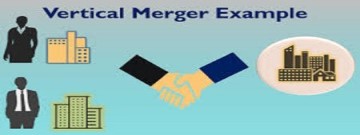Vertical Merger Definition
In this article we discuss vertical mergers with examples. These are commonplace in the M&A space and take place when two (or more) firms operating along different parts of the same product chain or services combine to form an enlarged entity. It is not necessary that the firms be in the same geographic area.
Unlike horizontal mergers, these mergers are more common in industries with many competitors. Since competition in an industry with many competitors tends to be higher, the goal is to create a larger business with greater control over all aspects of the product. This helps increase market share and economies of scale whilst streamlining the delivery of the product from inception to the marketplace. Because of the size and scale of some of these mergers, it is sometime difficult to discern whether the combination is a merger or acquisition.
To address this issue we have a separate article entitled The Differences Between Mergers and Acquisitions – Examples & Explanations to assist our readers. This article forms parts of a series of articles on types of merger and acquisitions. For more information on horizontal mergers please view our article Horizontal Mergers With Examples – A Complete Guide or our mergers and acquisitions category page.

How Vertical Mergers Create Value
The primary reasons for the vertical combination depend upon the direction the company wishes to move along the value chain. In the case of “backward integration”, the acquirer is seeking a dependable source of supply. This may also assist in time considerations such as inventory management. Costs can be reduced if a timely and reliable source of can be achieved. This is the focus of backward integration. It is an illusion to think the parent company can benefit from paying lower prices to the subsidiary as this is ultimately just a paper transfer. The real benefit comes from the securing of inputs into the firm and minimizing disruptions.
Specialized inputs is another source of danger for the parent firm. In this case they may be at the mercy of a handful of specialist manufactures which could potential wield an unusually large amount of power of the acquirer firm. To eliminate this risk, the parent can acquire such specialist skills and continue operating without interruption. As the firm expands further and further back along the value chain, the combination of the firms increases the buying power of the combined entity and puts pressure upon the next supplier to lower the cost of the inputs supplied to the combined firm. This is a further benefit to this type of expansion as inputs become cheaper. Michael E. Porter refers to this as one of his five forces in his book Competitive Strategy as the Bargaining power of customers.
The Danger of Vertical Mergers
Simultaneous corporate actions in both direction can help guarantee the firm that it can continue to do business with less interruption from its competitors. Uninterrupted expansion in both directions can result in what is known as a vertical monopoly. Vertical integration and expansion can become undesirable when its actions become anti-competitive and impede free competition in an open marketplace. Currently, the Hart-Scott-Rodino (HSR) Act which covers the Pre-Merger Notification program is the front line combatting this issue. Standard Oil was the famous first instance of this that led to the trust busting legislation in the early 20th century. Standard Oil tried to control all aspect from oil exploration and production to transportation and to retail. This ultimately led the firm to be broken up as its monopolistic practices became unacceptable.
Another disadvantage of vertical integration is the significant amounts of capital investment required. This may cause an excessive debt burden for the company. As profit maximization is not the primary driving factor behind this strategy, generating a financial return which justifies this level of investment may be difficult. This is despite the advantages listed above.
Advantages and Disadvantages of Vertical Mergers at a Glance
Advantages
Lower transaction costs
Synchronization of supply and demand
Lower uncertainty and higher investment
Ability to monopolize market
Disadvantages
Higher monetary and organizational costs
Weaker motivation for good performance
Specific investment
Loss of focus
Recent Vertical Mergers with Examples
- A more recent example of vertical integration would be the corporate strategy followed by Netflix (NFLX). The company famously started out as simply a DVD rental company offering a large selection of films via mail. As the physical rental market declined, Netflix took advantage of technological advances to offer movies and TV shows digitally. The company’s management then decided they could increase revenue by moving into original content creation. Netflix is now able to control all aspect of the production and distribution process of its proprietary original content. This is in addition to the distribution of content from other providers such as major film studios.
- Alibaba (BABA) has grown to be one of the largest companies in the world. It originally began, and remains most famous for being an e-commerce platform that is now available in nearly all parts of the world. However, as this continued expansion means growth for the platform is more and more difficult to achieve, the company has had to expand into other areas. This has been achieved by the takeover of product sourcing and warehousing, or backward integration, of operations closer to the source. At the same time, Alibaba has expanded into distribution and payment systems, operations closer to the consumer and therefore referred to as forward integration.
More Vertical Mergers with Examples
- In 1984, Chevron (CVX) bought the Gulf Oil Company. Chevron was looking for a target company that owned extensive oil reserves as it had depleted its own reserves below the industry average. As this move is the purchase of a rival company that is closer to the source product, the takeover is called “Backward Integration”.
- At around this time the oil industry was undergoing a state of consolidation. Mobil (now ExxonMobil, XOM) was in a similar position to Chevron and was also looking for a target to buy which could help increase its reserves. That target was Superior Oil. Whereas Mobil was traditionally strong in refining oil and marketing, the finished product to the consumer this had left them weaker in other areas of the business. Therefore, Mobil also needed to strengthen its position further back up the value chain closer to the source product. It did this by buying Superior Oil who were indeed superior in the exploration and drilling for oil and gas.
Key Takeaways
- Vertical backward integration is when a company expands to own or control its suppliers or distributors on the production path
- Vertical forward integration is when a company expands to own or control its retail locations for the supply of their products.
- These two methods give the company greater control over its supply chain.
- The benefits of vertically integrated companies give them the ability to control the processes, reduce costs, and improve efficiencies in bringing the product to market.
Finding this information useful? Here's what you can do to help...
- Share this page using the toolbar links at the left of your screen or at the bottom for mobile users on your preferred social network
- Sina Weibo
- Twitter etc.
- Follow us on twitter @MergeArbLimited.
- Become friends with us on Facebook
- Register for news alerts and merger arbitrage deal analysis postings via email using the sign up form.
- In addition to these, an RSS feed is also available at the bottom right of the page.
- Contact us using the details given on the Contact Us page.
- Donate using the paypal widget in the sidebar. It’s gladly appreciated and we need the coffee! See the Paypal section for additional incentives
- Share this page using the toolbar links at the left of your screen or at the bottom for mobile users on your preferred social network
Thanks for reading!







